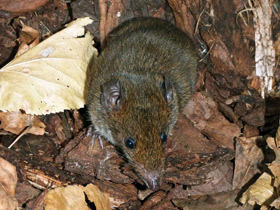The short-tailed gymnure (Hylomys suillus)
Gymnures, also called hairy hedgehogs or moonrats (subfamily Galericinae).
Gymnures, also called hairy hedgehogs or moonrats, are mammals belonging to the subfamily Galericinae, in the family Erinaceidae and the order Eulipotyphla. Gymnures resemble rats but are not closely related as they are not rodents; they are instead closely related to hedgehogs, which also belong to Erinaceidae. They are thought to have appeared in Eastern Asia before their closest relatives, and changed little from the original ancestor, which is thought to have been also the ancestor of the shrews.
Classification
This subfamily has alternately been called Echinosoricinae, Galericinae, and Hylomyinae. Some researchers prefer Hylomyinae because the specific relationships of the extinct genus Galerix to living erinaceids are uncertain. There are ten extant species in five genera:
- Genus Echinosorex:
- Echinosorex gymnura (moonrat);
- Genus Hylomys:
- Hylomys megalotis (Long-eared gymnure);
- Hylomys parvus (dwarf gymnure);
- Hylomys suillus (short-tailed gymnure or lesser moonrat);
- Genus Neohylomys:
- Neohylomys hainanensis (Hainan gymnure or Hainan moonrat);
- Genus Neotetracus:
- Neotetracus sinensis (shrew gymnure):
- Genus Podogymnura:
- Podogymnura aureospinula (Dinagat gymnure or Dinagat moonrat);
- Podogymnura intermedia (Eastern Mindanao gymnure );
- Podogymnura minima;
- Podogymnura truei (Mindanao gymnure or Mindanao moonrat).
The short-tailed gymnure (Hylomys suillus) is a small mammal from the family of the Erinaceidae. The scientific name of the species is first published by Salomon Müller in 1840.
There are 8 modern species inhabiting the tropical forests of Southeast Asia, including China, Sumatra and the Malay Peninsula, Burma, Thailand, Malaysia and Vietnam. They are found in habitats with sparse tropical vegetation (forests and shrubs), mainly on mountains and hills. They feed on insects and other invertebrates.
Description, nutrition and characteristics of Hylomys suillus
Hylomys suillus looks more like a large rat or Virginia opossum. They have a large head, which occupies about one-third of the body, and a naked tail. Their fur is thick, coarse or smooth, without needles.
Hylomys suillus is common in Southeast Asia. It is the smallest member of the Hylomys suillus, with a body length of 100 to 140 mm (tail length up to 25 mm) and a weight of 45 to 80 g.
The body of Hylomys suillus is elongated and the limbs are rather short. The head is large, with well-developed ear pinnae with rounded corners. The eyes are relatively large. The muzzle is strongly elongated and tapering in the terminal region. The coat is dense and soft, dark brown with a yellowish or greyish tinge on the dorsal side, greyish, dirty yellowish or yellowish on the ventral side. The lack of protective needles is compensated for by a pungent, unpleasant odour, similar to that of onions or garlic. Hylomys suillus can be found not only at night but also during the day.
They feed on insects, earthworms, small reptiles and amphibians and rodents. Hylomys suillus are also partially herbivorous and feed on a variety of fruits and fungi.
















































